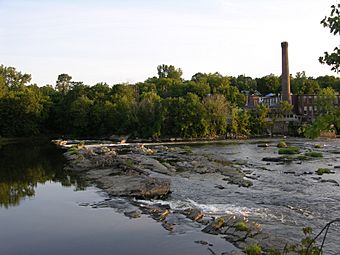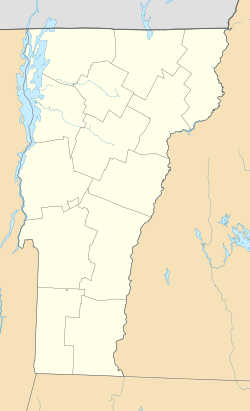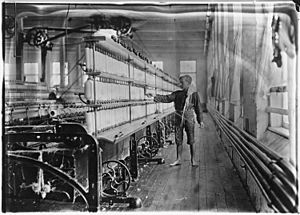Winooski Falls Mill District facts for kids
|
Winooski Falls Mill District
|
|

Chace Mill on the Winooski Falls
|
|
| Location | Winooski and Burlington, Vermont |
|---|---|
| Area | 20 acres (8.1 ha) (original size) 1.4 acres (0.57 ha) (size of 1993 increase) |
| NRHP reference No. | 79000223 (original) 93001009 (increase 1) 09000916 (increase 2) |
Quick facts for kids Significant dates |
|
| Added to NRHP | May 9, 1978 |
| Boundary increases | September 30, 1993 November 12, 2009 |
The Winooski Falls Mill District is a special historical area located along the Winooski River in Winooski and Burlington, Vermont. This district was once a very important industrial center in the 1800s. Many factories, called mills, were built here because of the powerful waterfalls on the river. These mills used the river's energy to make things like cloth.
Contents
Where are the Winooski Falls Mills?
The Winooski River flows into Lake Champlain. The city of Burlington is on the south side of the river, and Winooski and Colchester are on the north side. The Winooski Falls Mill District is found between two sets of waterfalls on the river. The historic district includes mills built on both sides of the river at the lower falls.
History of the Mills
In 1789, a man named Ira Allen built a dam across the upper falls. He used the water power to run two sawmills. These mills cut timber (wood) to sell to the British market in Québec.
Later, in 1835, the Burlington Woolen Mill was built near the lower falls. This mill made woolen cloth. It was one of the first mills to hire young, single women to work there, similar to how mills in Lowell, Massachusetts operated. Houses were built nearby for these workers.
In 1846, the Winooski Mill, which was a cotton mill, was built on the Burlington side of the river. It later became the Burlington Cotton Mill in 1888.
Wool became more popular in the 1860s, especially during the Lancashire Cotton Famine when cotton was hard to get. This led to new wool mills being built. More workers were needed, and many French Canadian and Irish people came to work in the mills. The Colchester Merino Mill and the Winooski Worsted Mill were built in the 1880s.
In 1902, the American Woolen Company bought all the mills and updated them with new machines. The Champlain Mill was built in 1912. By 1922, the American Woolen Company was the biggest employer in Vermont. Because of this growth, Winooski Falls became its own city, separate from Colchester.
However, in 1927, a huge flood hit the area. The dams were destroyed, and many mills were badly damaged. Some never reopened. All the mills finally closed in 1954.
Child Labor in the Mills
In the early 1900s, it was common for children to work in factories, including the mills in Winooski. This was called child labor. Children often worked long hours in dangerous conditions for very little pay.
Lewis Hine's Photographs
Lewis Hine was an American photographer and sociologist who used his camera to help change society. He became a photographer for the National Child Labor Committee (NCLC) in 1908. For the next ten years, Hine took pictures of children working in American industries. His photos helped the NCLC convince lawmakers to create new child labor laws and stop this practice.
In 1909, Lewis Hine visited the Chace Mill in Burlington. He took pictures of children working there. These photos show young workers, often with French Canadian names, doing important jobs in the mill. They also show the types of machines used at that time, like "mule spinning" machines, which were not very common in the U.S.
Important Mill Buildings
Many large buildings made up the Winooski Falls Mill District. Here are some of the most important ones:
Burlington Woolen Mill
This mill was five stories tall and made of local stone. It was built in 1837 over a canal that powered its waterwheel. A timber dam was built to provide water for the wheel. Sadly, this mill was destroyed by fire in 1961, and the timber dam was lost in the 1927 flood. In 1921, about 1,500 people worked here, making different kinds of wool cloth like Kerseys and Meltons.
Chace Cotton Mill
The Chace Cotton Mill was a three-story brick building. It was built in 1892 by the Burlington Mill Company. Water from the upper dam flowed through gates to power its waterwheel. The famous photos by Lewis Hine, showing child workers, were taken inside this mill. The mill changed its name to Chace Cotton Mill in 1912 when it was bought by the Chace Mills company.
Champlain Mill
The Champlain Mill was a large, five-story building. It was built in 1912 and was about 280 feet long and 100 feet wide.
Colchester Merino Mill
Built in 1880 and made bigger in 1902, the Colchester Merino Mill was part of a group of buildings. Its name tells us it was a wool mill that spun fine merino wool. It was a three-story brick building with strong wooden beams. It used an internal waterwheel powered by the lower falls.
Winooski Worsted Mill
This mill was in the same area as the Colchester Merino Mill. It made a different type of thread called Worsted. Worsted thread is made using a special process called combing, which is different from how regular wool is prepared. This building was similar in design to the Merino Mill.
Carbonizing Mill
Built in 1909, this two-story brick building was used for a specific step in cleaning wool. Raw wool would be sorted and cleaned in large vats with soap and water. However, this didn't remove all plant bits. In the carbonizing process, the wool went through a solution of acid to burn off any remaining burrs (plant seeds or thorns).
Timber Dam
A special dam made of timber (wood) was built across the river. What's interesting about this dam is that it was an early example of using concrete to fill in the timber structure. Today, a new hydro-electric project is planned for this spot.
What's There Now?
Today, the water channels from the old mills are used to power a modern 7.4-megawatt (MW) power generator. Some of the old mill buildings have been renovated and turned into modern apartments.
Images for kids








